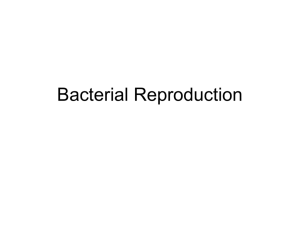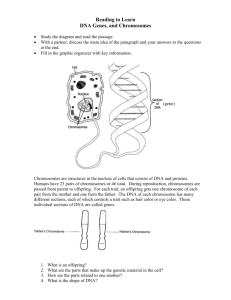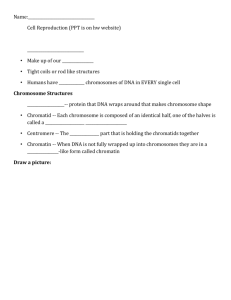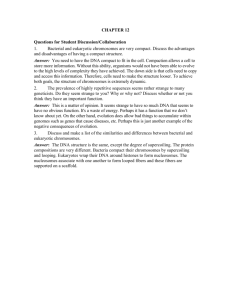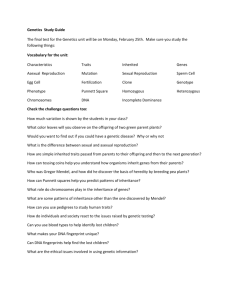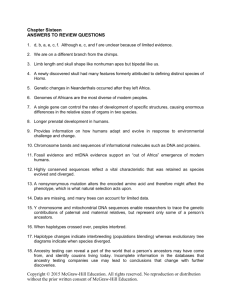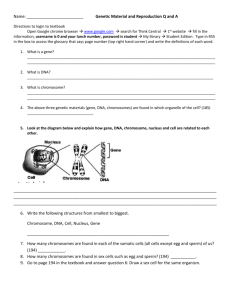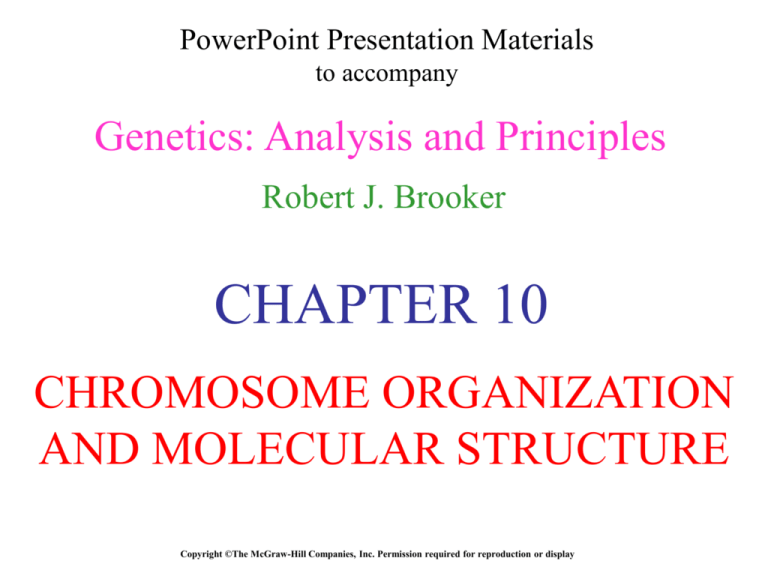
PowerPoint Presentation Materials
to accompany
Genetics: Analysis and Principles
Robert J. Brooker
CHAPTER 10
CHROMOSOME ORGANIZATION
AND MOLECULAR STRUCTURE
Copyright ©The McGraw-Hill Companies, Inc. Permission required for reproduction or display
INTRODUCTION
Chromosomes are the structures that contain the
genetic material
complexes of DNA and proteins
The genome comprises all the genetic material
that an organism possesses
In bacteria, it is typically a single circular chromosome
In eukaryotes, it refers to one complete set of nuclear
chromosomes
Note:
Eukaryotes possess a mitochondrial genome
Plants also have a chloroplast genome
Copyright ©The McGraw-Hill Companies, Inc. Permission required for reproduction or display
10-2
INTRODUCTION
The main function of the genetic material is to store
information required to produce an organism
The DNA molecule does that through its base sequence
DNA sequences are necessary for
1.
2.
3.
4.
Synthesis of RNA and cellular proteins
Proper segregation of chromosomes
Replication of chromosomes
Compaction of chromosomes
So they can fit within living cells
Copyright ©The McGraw-Hill Companies, Inc. Permission required for reproduction or display
10-3
Table 12-1
Copyright © 2006 Pearson Prentice Hall, Inc.
Figure 12-2
Copyright © 2006 Pearson Prentice Hall, Inc.
Figure 12-3
Copyright © 2006 Pearson Prentice Hall, Inc.
10.1 VIRAL GENOMES
Viruses are small infectious particles containing
nucleic acid surrounded by a capsid of proteins
For replication, viruses rely on their host cells
Refer to Figure 10.1
ie., the cells they infect
Most viruses exhibit a limited host range
They typically infect only specific types of cells of one
host species
Copyright ©The McGraw-Hill Companies, Inc. Permission required for reproduction or display
10-4
Bacteriophages may also contain a sheath, base plate and
tail fibers
Lipid bilayer
Refer to Figure 9.4
Figure 10.1 General structure of viruses
Picked up when
virus leaves host cell
10-5
Viral Genomes
The genome can be
DNA or RNA
Single-stranded or double-stranded
Circular or linear
Viral genomes vary in size from a few
thousand to more than a hundred thousand
nucleotides
Copyright ©The McGraw-Hill Companies, Inc. Permission required for reproduction or display
10-6
Copyright ©The McGraw-Hill Companies, Inc. Permission required for reproduction or display
10-7
During an infection process, mature viral particles
need to be assembled
Viruses with a
simple structure
may self-assemble
Genetic material
and capsid proteins
spontaneously bind
to each other
Example: Tobacco
Figure 10.2
mosaic virus
Capsid
protein
Capsid composed of 2,130
identical protein subunits
Copyright ©The McGraw-Hill Companies, Inc. Permission required for reproduction or display
10-8
10.2 BACTERIAL
CHROMOSOMES
The bacterial chromosome is found in a
region called the nucleoid
Refer to Figure 10.3
The nucleoid is not membrane-bounded
Copyright ©The McGraw-Hill Companies, Inc. Permission required for reproduction or display
10-10
Fig. 10.3
Bacterial chromosomal DNA is usually a circular
molecule that is a few million nucleotides in length
A typical bacterial chromosome contains a few
thousand different genes
Escherichia coli ~ 4.6 million base pairs
Haemophilus influenzae ~ 1.8 million base pairs
Structural gene sequences (encoding proteins) account
for the majority of bacterial DNA
The nontranscribed DNA between adjacent genes are
termed intergenic regions
Figure 10.4 summarizes the key features of
bacterial chromosomes
Copyright ©The McGraw-Hill Companies, Inc. Permission required for reproduction or display
10-11
A few hundred
nucleotides in length
These play roles in DNA folding, DNA
replication, and gene expression
Figure 10.4
Copyright ©The McGraw-Hill Companies, Inc. Permission required for reproduction or display
10-12
To fit within the bacterial cell, the chromosomal
DNA must be compacted about a 1000-fold
This involves the formation of loop domains
The looped structure compacts
the chromosome about 10-fold
Figure 10.5
The number of loops varies according to the size of the
bacterial chromosome and the species
E. coli has 50-100 with 40,000 to 80,000 bp of DNA in each
Copyright ©The McGraw-Hill Companies, Inc. Permission required for reproduction or display
10-13
DNA supercoiling is a second important way to
compact the bacterial chromosome
Supercoiling within loops creates
a more compact DNA
Figure 10.6
Figure 10.7 provides a schematic illustration of
DNA supercoiling
Copyright ©The McGraw-Hill Companies, Inc. Permission required for reproduction or display
10-14
Figure 10.7
Plates preventing DNA
ends from rotating freely
Fewer turns
Both overwinding and
underwinding can
induce supercoiling
These two DNA conformations do
not occur in living cells
More turns
These three DNA conformations are
topoisomers of each other
10-15
Figure 12-4
Copyright © 2006 Pearson Prentice Hall, Inc.
Chromosome Function Is
Influenced by DNA Supercoiling
The chromosomal DNA in bacteria is negatively
supercoiled
In E. coli, there is one negative supercoil per 40 turns of
the double helix
Negative supercoiling has two major effects
1. Helps in the compaction of the chromosome
Refer to Figure 10.6
2. Creates tension that may be released by DNA
strand separation
Refer to Figure 10.8
Copyright ©The McGraw-Hill Companies, Inc. Permission required for reproduction or display
10-16
This enhances DNA
replication and
transcription
Figure 10.8
Copyright ©The McGraw-Hill Companies, Inc. Permission required for reproduction or display
10-17
The control of supercoiling in bacteria is
accomplished by two main enzymes
1. DNA gyrase (also termed DNA topoisomerase II)
Introduces negative supercoils using energy from ATP
It can also relax positive supercoils when they occur
2. DNA topoisomerase I
Refer to Figure 10.9
Relaxes negative supercoils
The competing action of these two enzymes
governs the overall supercoiling of bacterial DNA
Copyright ©The McGraw-Hill Companies, Inc. Permission required for reproduction or display
10-18
10.3 EUKARYOTIC
CHROMOSOMES
Eukaryotic species contain one or more sets of
chromosomes
Each set is composed of several different linear chromosomes
The total amount of DNA in eukaryotic species is
typically greater than that in bacterial cells
Chromosomes in eukaryotes are located in the
nucleus
To fit in there, they must be highly compacted
This is accomplished by the binding of many proteins
The DNA-protein complex is termed chromatin
Copyright ©The McGraw-Hill Companies, Inc. Permission required for reproduction or display
10-21
Eukaryotic genomes vary substantially in size
Refer to Figure 10.10a
In many cases, this variation is not related to
complexity of the species
For example, there is a two fold difference in the size of
the genome in two closely related salamander species
Refer to Figure 10.10b
The difference in the size of the genome is not because
of extra genes
Rather, the accumulation of repetitive DNA sequences
These do not encode proteins
Copyright ©The McGraw-Hill Companies, Inc. Permission required for reproduction or display
10-22
Fig. 10.10
Organization of Eukaryotic
Chromosomes
A eukaryotic chromosome contains a long, linear
DNA molecule
Refer to Figure 10.11
Three types of DNA sequences are required for
chromosomal replication and segregation
Origins of replication
Centromeres
Telomeres
Copyright ©The McGraw-Hill Companies, Inc. Permission required for reproduction or display
10-24
Figure 10.11
10-25
Genes are located between the centromeric and
telomeric regions along the entire chromosome
A single chromosome usually has a few hundred to
several thousand genes
In lower eukaryotes (such as yeast)
Genes are relatively small
They contain primarily the sequences encoding the polypeptides
ie: Very few introns are present
In higher eukaryotes (such as mammals)
Genes are long
They tend to have many introns
Copyright ©The McGraw-Hill Companies, Inc. Permission required for reproduction or display
10-26
Repetitive Sequences
Sequence complexity refers to the number of
times a particular base sequence appears in
the genome
There are three main types of repetitive
sequences
Unique or non-repetitive
Moderately repetitive
Highly repetitive
Copyright ©The McGraw-Hill Companies, Inc. Permission required for reproduction or display
10-27
Repetitive Sequences
Unique or non-repetitive sequences
Found once or a few times in the genome
structural genes (control regions, exons and introns)
intergenic areas
Moderately repetitive
Found a few hundred to a few thousand times
Includes
Genes for rRNA and histones
Origins of replication
Transposable elements
Discussed in detail in Chapter 17
Copyright ©The McGraw-Hill Companies, Inc. Permission required for reproduction or display
10-28
Repetitive Sequences
Highly repetitive
Found tens of thousands to millions of times
Each copy is relatively short (a few nucleotides to several
hundred in length)
Some sequences are interspersed throughout the genome
Example: Alu family in humans
Discussed in detail in Chapter 17
Other sequences are clustered together in tandem arrays
Example: AATAT and AATATAT sequences in Drosophila
These are commonly found in the centromeric regions
Copyright ©The McGraw-Hill Companies, Inc. Permission required for reproduction or display
10-29
Figure 10.13
Copyright ©The McGraw-Hill Companies, Inc. Permission required for reproduction or display
10-38
Figure 10-21
Copyright © 2006 Pearson Prentice Hall, Inc.
Effect of base composition on DNA
melting temperature
• Hyperchromic shift during DNA
denaturation is used to determine the melting
temperature (Tm) (Figure 10.20). Melting
temperature is a method for estimating the
base composition of DNA.
•G:C base pairs more stable than A:T base
pairs
Figure 10-20
Copyright © 2006 Pearson Prentice Hall, Inc.
Eukaryotic Chromatin Compaction
If stretched end to end, a single set of human
chromosomes will be over 1 meter long!
Yet the cell’s nucleus is only 2 to 4 mm in diameter
The compaction of linear DNA involves interactions
between DNA and various proteins
Copyright ©The McGraw-Hill Companies, Inc. Permission required for reproduction or display
10-43
Nucleosomes
The repeating structural unit within eukaryotic
chromatin is the nucleosome
It is composed of double-stranded DNA wrapped
around an octamer of histone proteins
An octamer is composed two copies each of four different
histones
146 bp of DNA make 1.65 negative superhelical turns
around the octamer
Refer to Figure 10.14a
Copyright ©The McGraw-Hill Companies, Inc. Permission required for reproduction or display
10-44
Vary in length between 20 to 100 bp,
depending on species and cell type
Diameter of the
nucleosome
Figure 10.14
Overall structure of connected nucleosomes resembles “beads on a string”
This structure shortens the DNA length about seven-fold
Copyright ©The McGraw-Hill Companies, Inc. Permission required for reproduction or display
10-45
Histone proteins are basic
They contain many positively-charged amino acids
Lysine and arginine
These bind with the phosphates along the DNA backbone
There are five types of histones
H2A, H2B, H3 and H4 are the core histones
Two of each make up the octamer
H1 is the linker histone
Binds to linker DNA
Also binds to nucleosomes
But not as tightly as are the core histones
Refer to Figure 10.14b
Copyright ©The McGraw-Hill Companies, Inc. Permission required for reproduction or display
10-46
Play a role in the
organization and compaction
of the chromosome
Figure 10.14
Copyright ©The McGraw-Hill Companies, Inc. Permission required for reproduction or display
10-47
Experiment 10B: Nucleosome
Structure Revealed
The model of nucleosome structure was proposed
in 1974 by Roger Kornberg
Kornberg based his proposal on various
observations about chromatin
Biochemical experiments
X-ray diffraction studies
Electron microscopy images
Copyright ©The McGraw-Hill Companies, Inc. Permission required for reproduction or display
10-48
Figure 12-8a
Copyright © 2006 Pearson Prentice Hall, Inc.
Experiment 10B: Nucleosome
Structure Revealed
Markus Noll tests Kornberg’s model
He did this via the following procedure
Digest DNA with the enzyme DNase I
Accurately measure the molecular weight of the
resulting DNA fragments
The rationale is that the linker DNA is more
accessible than the “core DNA” to the DNase I
Copyright ©The McGraw-Hill Companies, Inc. Permission required for reproduction or display
10-49
The Hypothesis
The experiment tests the beads-on-a-string model
of chromatin structure
It the model is correct, DNase I should cut in the linker
region
Thereby producing DNA pieces that are about 200 bp long
Testing the Hypothesis
Refer to Figure 10.15
Copyright ©The McGraw-Hill Companies, Inc. Permission required for reproduction or display
10-50
Figure 10.15
10-51
The Data
30 units
ml-1
Copyright ©The McGraw-Hill Companies, Inc. Permission required for reproduction or display
10-52
Interpreting the Data
These longer pieces were
all in multiples of 200 bp
At low concentrations,
DNase I did not cut at all
the linker DNA
And this, three
All chromosomal
DNA digested into
fragments that are
~ 200 bp in length
This fragment
contains two
nucleosomes
30 units
ml-1
Copyright ©The McGraw-Hill Companies, Inc. Permission required for reproduction or display
10-53
Nucleosomes Join to Form
a 30 nm Fiber
Nucleosomes associate with each other to form a
more compact structure termed the 30 nm fiber
Histone H1 plays a role in this compaction
At moderate salt concentrations, H1 is removed
At low salt concentrations, H1 remains bound
The result is the classic beads-on-a-string morphology
Beads associate together into a more compact morphology
Refer to Figure 10.16
Copyright ©The McGraw-Hill Companies, Inc. Permission required for reproduction or display
10-54
Fig. 10.16
The 30 nm fiber shortens the total length of DNA
another seven-fold
Its structure has proven difficult to determine
The DNA conformation may be substantially altered
when extracted from living cells
Two models have been proposed
Solenoid model
Three-dimensional zigzag model
Refer to Figure 10.17b and c
Copyright ©The McGraw-Hill Companies, Inc. Permission required for reproduction or display
10-55
Regular, spiral
configuration
containing six
nucleosomes per turn
Irregular
configuration where
nucleosomes have
little face-to-face
contact
Figure 10.17
Copyright ©The McGraw-Hill Companies, Inc. Permission required for reproduction or display
10-56
Further Compaction of the
Chromosome
The two events we have discussed so far have
shortened the DNA about 50-fold
A third level of compaction involves interaction
between the 30 nm fiber and the nuclear matrix
The nuclear matrix is composed of two parts
Nuclear lamina
Internal matrix proteins
10 nm fiber and associated proteins
Copyright ©The McGraw-Hill Companies, Inc. Permission required for reproduction or display
10-57
Figure 10.18
Copyright ©The McGraw-Hill Companies, Inc. Permission required for reproduction or display
10-58
The third mechanism of DNA compaction involves
the formation of radial loop domains
Matrix-attachment
regions
or
Scaffold-attachment
regions (SARs)
Figure 10.18
25,000 to
200,000 bp
MARs are anchored
to the nuclear matrix,
thus creating radial
loops
Copyright ©The McGraw-Hill Companies, Inc. Permission required for reproduction or display
10-59
Further Compaction of the
Chromosome
The attachment of radial loops to the nuclear matrix
is important in two ways
1. It plays a role in gene regulation
Discussed in Chapter 15
2. It serves to organize the chromosomes within the
nucleus
Each chromosome in the nucleus is located in a discrete and
nonoverlapping chromosome territory
Refer to Figure 10.19
Copyright ©The McGraw-Hill Companies, Inc. Permission required for reproduction or display
10-60
Fig. 10.19
Heterochromatin vs Euchromatin
Euchromatin
Less condensed regions of chromosomes
Transcriptionally active
Regions where 30 nm fiber forms radial loop domains
Heterochromatin
Tightly compacted regions of chromosomes
Transcriptionally inactive (in general)
Radial loop domains compacted even further
10-61
Figure 10.21
10-63
Compaction level
in euchromatin
During interphase
most chromosomal
regions are
euchromatic
Compaction level
in heterochromatin
Figure 10.21
10-64
Fig. 10.21cd
Metaphase Chromosomes
As cells enter M phase, the level of compaction
changes dramatically
By the end of prophase, sister chromatids are entirely
heterochromatic
Two parallel chromatids have an overall diameter of
1,400 nm
These highly condensed metaphase chromosomes
undergo little gene transcription
Copyright ©The McGraw-Hill Companies, Inc. Permission required for reproduction or display
10-65
Metaphase Chromosomes
Fig. 10.22a
Fig. 10.22b

